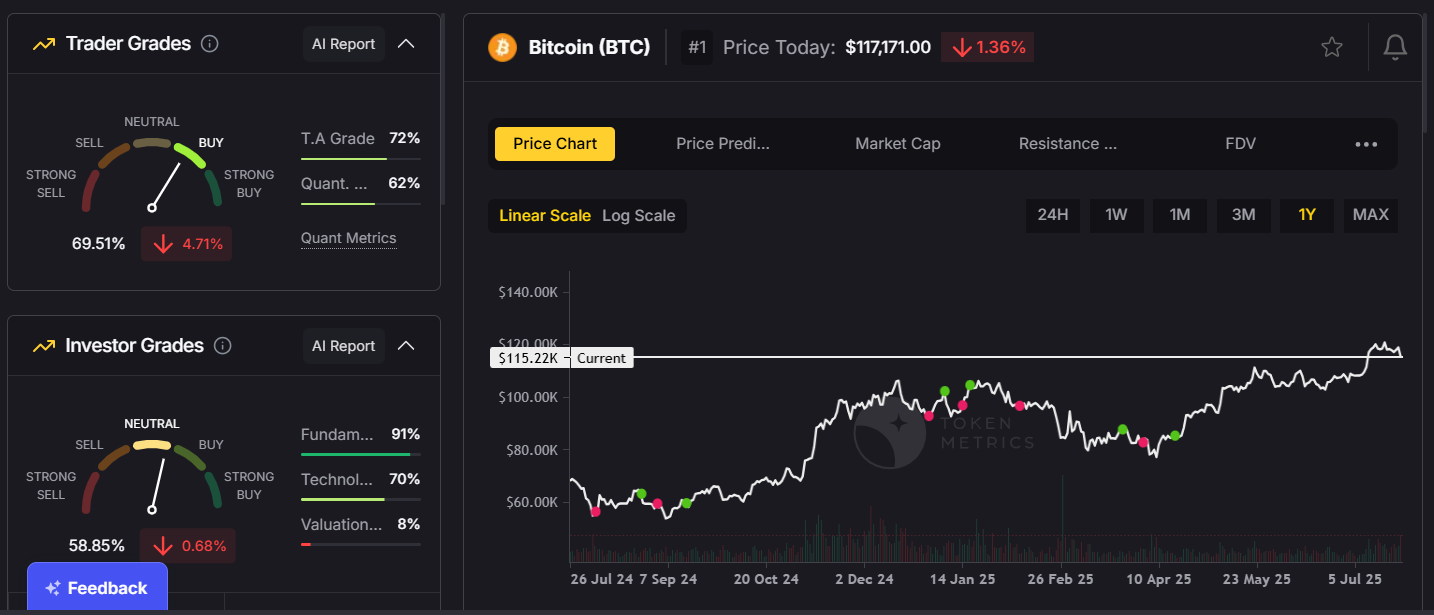How Do I Start Trading Cryptocurrency? A Beginner’s Guide for 2025

Introduction: Why Crypto Trading Is Worth Exploring
Cryptocurrency trading has grown from a niche activity into a global financial revolution, with billions traded daily across thousands of digital assets. In 2025, crypto trading isn’t just about buying Bitcoin—it’s a sophisticated market with opportunities in altcoins, AI tokens, DeFi protocols, and more.
But getting started can be overwhelming. If you’re asking, “How do I start trading cryptocurrency?”, this guide will walk you through everything—from setting up accounts to using AI‑powered tools like Token Metrics to trade smarter.

Step 1: Understand the Basics of Cryptocurrency
Before you trade, you need to understand what you’re trading.
- Cryptocurrencies: Digital assets like Bitcoin (BTC) and Ether (ETH) used for payments, smart contracts, and value storage.
- Altcoins: Alternative coins (e.g., Token Metrics AI (TMAI), Polygon (MATIC)) offering different use cases.
- Stablecoins: Pegged to fiat (e.g., USDC) for lower volatility.
- DeFi & NFTs: Tokens linked to decentralized finance apps and digital collectibles.
Pro Tip: Use Token Metrics’ coin ratings to evaluate projects based on fundamentals, technicals, and on‑chain data.
Step 2: Choose a Reliable Crypto Exchange
To start trading, you’ll need an account on a crypto exchange.
Centralized Exchanges (CEXs):
- Examples: Coinbase, Binance, Kraken.
- Pros: Beginner‑friendly, high liquidity.
- Cons: Custodial (exchange controls your funds).
Decentralized Exchanges (DEXs):
- Examples: Uniswap, SushiSwap.
- Pros: No middlemen, full control over assets.
- Cons: Requires a wallet and understanding of smart contracts.
Pro Tip: Start with a reputable CEX, then gradually explore DEXs as you gain experience.
Step 3: Set Up a Secure Wallet
A wallet stores your crypto securely.
- Hot Wallets (e.g., MetaMask): Connected to the internet, easy to use, but less secure.
- Cold Wallets (e.g., Ledger, Trezor): Offline hardware devices, ideal for long‑term storage.

Rule of Thumb:
- Keep trading funds on an exchange.
- Move long‑term holdings to a cold wallet.
Step 4: Fund Your Account
To trade, you’ll need to deposit money:
- Fiat On‑Ramp: Use bank transfers or cards to buy crypto directly on exchanges.
- Peer‑to‑Peer (P2P): Purchase crypto directly from other users.
Pro Tip: Always use verified exchanges to avoid scams.
Step 5: Learn Basic Trading Types
Crypto trading isn’t just buying and holding. Common strategies include:
- Spot Trading: Buy and sell crypto at market price.
- Futures & Margin Trading: Trade with leverage (advanced, high risk).
- Swing Trading: Hold for days or weeks to capitalize on price swings.
- Scalping: Make multiple small trades throughout the day.
Pro Tip: Start with spot trading before exploring advanced strategies.
Step 6: Analyze the Market
Trading requires informed decisions, not guesses.
Types of Analysis:
- Fundamental Analysis: Study project teams, technology, tokenomics.
- Technical Analysis: Use price charts, indicators (e.g., RSI, MACD) to predict trends.
- On‑Chain Analysis: Examine blockchain activity—wallet movements, developer engagement.
Token Metrics simplifies this with AI‑powered coin ratings, narrative detection, and real‑time analytics.
Step 7: Start Small
Crypto is volatile. Start with a small allocation (1–5% of your portfolio) while you learn the ropes.
Golden Rule:
Never invest money you can’t afford to lose.
Step 8: Manage Risk
Risk management is critical for long‑term success.
- Use Stop‑Loss Orders: Automatically exit losing positions.
- Take Profits Gradually: Lock in gains at target levels.
- Diversify: Don’t put all your funds in one coin.
- Keep Stablecoins: Use them to hedge during market downturns.
Pro Tip: Token Metrics’ portfolio optimizer can help balance risk and return.
Step 9: Develop a Trading Plan
Don’t trade emotionally. Create a plan that includes:
- Entry & Exit Points: Define when to buy and sell.
- Profit Targets: Set clear goals for each trade.
- Time Horizon: Are you day trading or long‑term investing?
AI‑powered tools like Token Metrics can automate alerts for your planned price levels.
Step 10: Stay Informed
The crypto market moves fast. Keep learning:
- Follow News & Regulations: Stay updated on global crypto policies.
- Track Narratives: Use Token Metrics to spot emerging trends like AI tokens or DeFi 2.0.
- Engage with Communities: Join crypto forums, Twitter spaces, and Discord groups.
Beginner Mistakes to Avoid
- FOMO Buying: Don’t chase coins after big pumps
- Overleveraging: Avoid high leverage until you gain experience.
- Ignoring Security: Always enable 2FA and use secure wallets.
- No Exit Plan: Define profit targets before entering trades.
How AI Makes Trading Easier
Trading doesn’t have to be guesswork. AI platforms like Token Metrics help by:
- Generating Coin Ratings: Evaluating over 80 data points per token.
- Detecting Narratives Early: Finding trends before they explode.
- Portfolio Optimization: Suggesting ideal allocations for your goals.
- Real‑Time Alerts: Notifying you when coins hit your targets.
With AI, even beginners can trade like seasoned professionals.
Conclusion
Starting your crypto trading journey in 2025 is easier than ever — but success requires planning, discipline, and the right tools.
By choosing a reliable exchange, using secure wallets, starting small, and leveraging AI‑driven insights from Token Metrics, you can confidently navigate the crypto market and turn trading into a profitable venture.
In crypto, knowledge is power — and in 2025, AI‑powered knowledge is the ultimate advantage.
Create Your Free Token Metrics Account

.png)




%201.svg)
%201.svg)


%201.svg)





_%20A%20Complete%20Guide%20to%20the%20Meme%20Coin%20in%202025.png)

_%20A%20Complete%20Guide%20to%20Ethereum%E2%80%99s%20Native%20Token%20in%202025.png)






.svg)




.png)